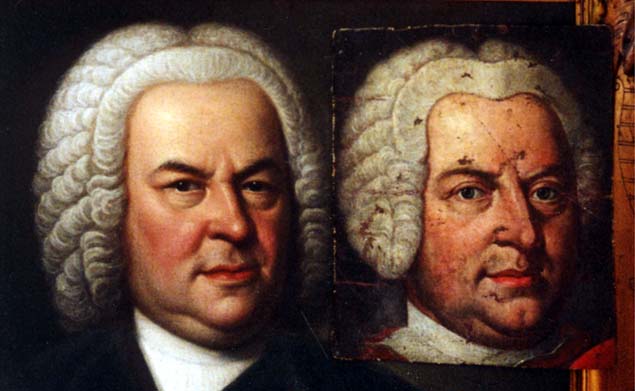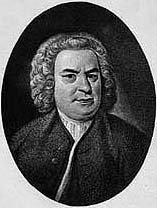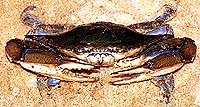The Present Day Misconceptions About Bach Performance Practice in the 19th Century - The Evidence of the Recordings Pages at the Teri Noel
Towe Home Pages - Page 2 - Siegfried Ochs and Hans Weisbach
Johann Sebastian Bach
Present Day Misconceptions
About Bach Performance Practice in the Nineteenth Century
The Evidence of the Recordings
This remarkable photograph is not a computer generated composite; the original of the Weydenhammer Portrait Fragment, all that
remains of the portrait of Johann Sebastian Bach that belonged to his pupil Johann Christian Kittel, is resting gently on the surface
of the original of the 1748 Elias Gottlob Haussmann Portrait of Johann Sebastian Bach.

1748 Elias Gottlob Haussmann Portrait, Courtesy of William H. Scheide, Princeton, New Jersey
Weydenhammer Portrait Fragment, ca. 1733, Artist Unknown, Courtesy of the Weydenhammer Descendants
Photograph by Teri Noel Towe
©Teri Noel Towe, 2001, All Rights Reserved
PRESENT DAY MISCONCEPTIONS
ABOUT BACH PERFORMANCE PRACTICE IN THE NINETEENTH CENTURY
THE EVIDENCE OF THE RECORDINGS
Page 2
Siegfried Ochs and Hans Weisbach
Siegfried Ochs's account, with the Berliner Philharmonischer Chor, of the same chorus, recorded a dozen or so years earlier,
represents the opposite extreme. [6] With its long, vehement phrases and its fast, urgent tempo, it is the very antithesis of
Mengelberg's performance, but it may well provide a more accurate indicium of the prevailing mainstream 19th-century Bach
performance style than Mengelberg's, and it is surely more representative of the kind of Bach performance heard in Germany at the
time of Mendelssohn-Bartholdy, Schumann, and Brahms. For the orchestral introduction, Ochs sets a tempo of dotted quarter note
= 72 to 74, but he slows down to dotted quarter note = 70 to 72 when the chorus enters; at bar 26 - the "Sehet? Wie?" antiphonal
passages - he slows the tempo to dotted quarter note = 63 to 68, almost as though introducing the second theme in the "old"
German symphonic fashion; and at bars 37 and 38 he ritards the tempo to an average of dotted quarter note = 57, but he quickly
returns to the brisk tempos he had previously established. (Incidentally, lest someone claim that Ochs rushed the tempo of the
opening chorus of the Saint Matthew Passion in order to fit the work onto two sides of a 78, that is highly unlikely. The
performance is split over two sides of a 12" disc, and lasts 5 minutes, 26 seconds. At the time this recording was made, the
standard working maximum for a 12" side was 4 minutes, 25 seconds. There were, therefore, 3 minutes, 34 seconds of which Ochs
could have taken advantage, but didn't.)
Born in Frankfurt-am-Main in 1858, Ochs abandoned the prospect of a successful career as a chemist in his late teens and moved
to Berlin, where he studied at the Hochschule für Musik, taking ensemble playing form Joseph Joachim and choral singing from
Adolf Schulze. The choral society that Ochs founded in 1882 became the Berlin Philharmonic Choir in 1888, and was conducted
several times between 1888 and 1892 by Hans von Bulow, who had studied with Moritz Hauptmann in Leipzig. Von Bulow was a
prominent figure in the Bach revival and an admirer of Ochs's work. A founding member of the Neue Bach-Gesellschaft, Ochs was
something of a specialist in early music and made the first recording of any composition by Heinrich Schütz. He also gave the first
performance in Berlin of the Bruckner Te Deum. As Martin Elste remarked in his "New Grove" entry on Ochs, he was "noted for
his extreme care in rehearsing, fine musicianship, and natural sense of style (especially in early music)." [7] Ochs died in 1929.
What are the most important aspects of that biography as far as we are concerned? First, Ochs's interest in early music in general
and in Bach in particular. Second, Ochs's academic pedigree -- his training at the Hochschule für Musik in Berlin. This latter aspect
is of particular interest, especially since those who regard the Mengelberg type of performance as an accurate reflection of
19th-century Bach performance practice can easily argue that it was Ochs, and not Mengelberg, who deviated from the prevailing
style in a conscious attempt to resurrect a more "authentic" performance practice. Both his interest in early music and his founding
membership in the Neue Bach-Gesellschaft might be cited as support for that position. Conceivably those who so argue could be
right, but several factors suggest otherwise. The activities of such distinguished predecessors of Ochs as Mendelssohn-Bartholdy,
Brahms, Spitta, and Joachim -- all of whom shared a sincere commitment to early music and all of whom performed Bach in the
prevailing "modern" style of their time -- and Ochs's training at the Hochschule für Musik both argue cogently to the contrary.
Still, because it is the very antithesis of Mengelberg's, Ochs's performance of "Kommt ihr Tochter, helft mir klagen" is, therefore,
itself an extreme. Is there, perchance, something "in the middle" that is also representative of what we might call, for the moment, at
least, the Mendelssohn-Bartholdy tradition of Bach performance practice?
Gerhard Herz recalls the performances of Hans Weisbach as being characteristic of the traditional mainstream of Bach performance
practice in Germany during his youth in the 1920s and 1930s. [8] Fortunately, a concert performance of the Saint Matthew Passion,
given under Weisbach's baton in the Altes Gewandhaus in Leipzig on April 19, 1935, has been preserved on records. [9] His choice
of tempo for the opening chorus (duration: 7 minutes, 31 seconds) is not only markedly faster than Mengelberg's but also
appreciably slower than Ochs's. Perhaps more importantly, however, Weisbach's reading also strongly resembles Ochs's in its
urgent sense of forward motion and its long, vehement phrases. Weisbach's overall range of tempos is dotted quarter note = 44 -
53. He takes the orchestral introduction at dotted quarter note = 48 - 50; by the time the chorus enters the tempo is dotted quarter
note = 48, with a ritard to dotted quarter note = 44 to 47 at bar 26; at bars 37 and 38 he ritards to dotted quarter note = 44 but then
goes back up to a pace of dotted quarter note = 51.
As it turns out, Hans Weisbach -- who was born in 1885, and was thus almost two generations younger than Ochs -- was also a
product of the Hochschule für Musik in Berlin. There he was a pupil of Andreas Moser (1859-1925), a colleague, close friend, and
ultimately the biographer of Joseph Joachim.
After initially working for a couple of years as a vocal coach under Felix Mottl at the Munich Court Opera, Weisbach settled in
Frankfurt am Main, where he became the conductor of the Rühl'scher Gesangverein, thus, like Ochs, starting off as a choral
conductor. Weisbach's career led him in the direction of symphonic conducting -- he held conductorships, successively, at
Worms, Wiesbaden, Hagen, Barmen, and Düsseldorf (where Professor Herz, as a teenager, sang in the chorus in a Saint Matthew
Passion under his baton. [10]), before assuming the directorship of the Leipzig Radio Symphony Orchestra and Chorus in 1933, a
job he held until 1939. From 1939 until the end of World War II, Weisbach was the conductor of the Municipal Orchestra in
Vienna. In 1947, he became Music Director at Wuppertal, where he died in 1961. [11]
Weisbach was internationally known as a Bach specialist, and, for instance, led the first performance in England of Die Kunst der
Fuge, BWV 1080, in 1930; he repeated it, with the London Symphony Orchestra, in each of the ensuing six seasons. Once again
like Ochs, Weisbach was a fervent advocate of the music of Bruckner as well as that of Bach. [12]
Please click on  to advance to Page 3 - Joseph Joachim.
to advance to Page 3 - Joseph Joachim.
Click on  to return to the Johann Sebastian Bach Index Page.
to return to the Johann Sebastian Bach Index Page.
Click on the  to return to the Teri Noel Towe Welcome Page.
to return to the Teri Noel Towe Welcome Page.
teritowe@alumni.Princeton.EDU
Copyright, Teri Noel Towe, 1985, 1986, 1988, 1989, 2001
All Rights Reserved
The Present Day Misconceptions About Bach Performance Practice in the Nineteenth Century - The Evidence of the Recordings
Pages at the Teri Noel Towe Home Pages
are PPP Free web pages.

The Present Day Misconceptions About Bach Performance Practice in the Nineteenth Century - The Evidence of the Recordings
Pages at the Teri Noel Towe Home Pages have received
the HIP Woolly Mammoth Stamp of Approval from The HIP-ocrisy Home Page.